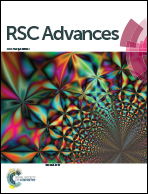Upgrading of anisole using in situ generated hydrogen in pin to plate pulsed corona discharge†
Abstract
In this paper, the upgrading of anisole as a model compound for lignin derived bio-oils has been studied experimentally via a pin to plate pulsed corona discharge for the first time. The required hydrogen is generated in situ by plasma decomposition of methyl radicals which exist in bio oil chemical structure. In order to maximize the conversion and improving the selectivity of products, some operating parameters including pulsed repetition frequency, pin number, gap distance, plate electrode diameter and carrier gas flow rate have been evaluated. According to the results, the main products were BTX and phenol. Demethylation, transalkylation, hydrogenolysis, demethoxylation and methyl decomposition are the main chemical reactions. Results reveal that the selectivity of the desired products was enhanced through increasing the decomposition of generated methyl radicals which can be obtained by increasing the energy and number of collisions in the discharge zone. The maximum anisole conversion of 68%, phenol selectivity of 45.6% and BTX selectivity of 21.6% were obtained. Due to the low temperature and atmospheric pressure conditions no hydrogenation of the aromatic ring was observed. The results indicated that the corona discharge plasma reactor can overcome the hydrogen challenges of the hydrodeoxygenation reaction.


 Please wait while we load your content...
Please wait while we load your content...